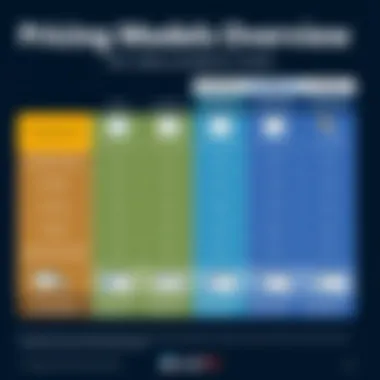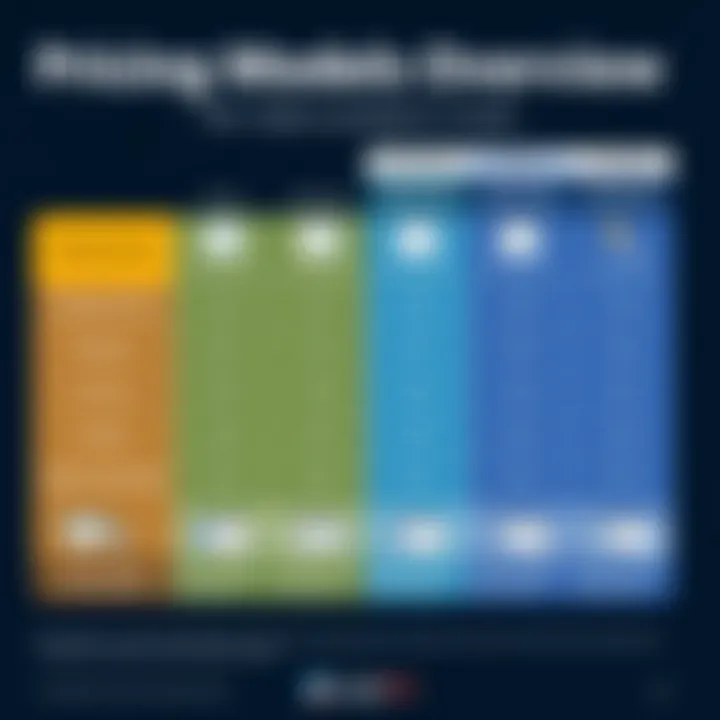Top Data Analytics Platforms: A Comprehensive Overview


Intro
In an age where data reigns supreme, the ability to sift through mountains of information and extract actionable insights is a non-negotiable skill for modern businesses. The landscape of data analytics platforms provides a myriad of tools that cater to various needs, whether one is a small startup or a sprawling enterprise. As organizations jockey for position in competitive markets, understanding the features and capabilities of these platforms becomes crucial. This article seeks to offer a compelling overview of the leading data analytics solutions available today, emphasizing their distinctive attributes, versatility, and suitability for various organizational contexts.
Every business has its unique challenges and objectives, and hence the choice of analytics tools can make or break strategic initiatives aimed at data-driven decision making. From intuitively designed user interfaces to robust integration potential with existing systems, each analytics platform comes with a set of features that can cater uniquely to individual business needs. In the sections that follow, we will delve deeper into these features, dissect various pricing models, and provide insights into how users can maximize their investment in these powerful tools.
With the data analytics market continually evolving, staying abreast of the latest offerings ensures that businesses do not miss out on opportunities for growth and efficiency. Whether you're a procurement manager, IT professional, or business owner, this overview will arm you with essential insights needed to navigate the complex world of data analytics platforms.
Foreword to Data Analytics Platforms
In today's digital era, the ability to navigate through vast oceans of data is not just a luxury; it's a necessity. Businesses are in constant pursuit of insights that can drive strategic decisions and improve their competitive edge. At the heart of this process are data analytics platforms, which serve as the tools that transform raw data into meaningful information.
Data analytics entails examining data sets to draw conclusions about the information they contain. This process is critical for organizations aiming to harness data for better decision-making. A well-established analytics platform can provide businesses with the necessary capabilities such as data mining, predictive analytics, and customer behavior tracking. The popularity of data analytics platforms can be attributed to their versatility and comprehensive functionalities, allowing users from various industries to benefit from data-generated insights.
Understanding Data Analytics
Understanding data analytics starts with recognizing its components: data collection, processing, analysis, and visualization. Each step plays a crucial role in where insights come from. For instance, consider a local restaurant that uses a data analytics platform to analyze customer preferences. By collecting data on customer orders, preferences, and feedback, the restaurant can identify which dishes are popular, leading them to optimize their menu. Data analytics also encompasses various methodologies, such as big data analytics, descriptive and inferential statistics, and machine learning. All this emphasizes the interplay of technology and analytics in deriving actionable insights.
By embracing these tools, businesses are better positioned to recognize trends, forecast outcomes, and make informed strategic choices. Moreover, the impact of data analytics stretches beyond just operational efficiency; it nurtures a culture of data-driven decision-making across the organization.
Importance of Data Analytics in Business
Data analytics can transform business strategies at their core. One primary reason for this is its ability to reveal customer insights. Understanding customer needs and preferences allows companies to tailor their offerings and enhance user experiences. For example, an eCommerce platform can utilize analytics to tailor marketing strategies and improve user engagement. This personalization often leads to higher conversion rates and fosters customer loyalty.
Furthermore, data analytics contributes to operational efficiency. Companies can analyze internal processes, identify bottlenecks, and monitor performance metrics, leading to informed decision-making that improves productivity. As a result, organizations that leverage analytics tend to be more agile, adapting quickly to changes in market dynamics or consumer behavior.
"In a world flooded with data, those who can interpret it possess the keys to unlock competitive advantage."
Each facet of data analytics, from understanding its mechanics to its robust impacts on business, underscores the importance of having the right tools in place. The subsequent sections of this article will delve deeper into the core components, features, and leading platforms in this thriving domain.
Key Features of Data Analytics Platforms
In the bustling world of data analytics, it’s essential to sift through various platforms to find the ones that best suit your organization's needs. The key features of data analytics platforms act as the backbone of their functionalities, dictating how well these tools can process vast amounts of information and convert it into actionable insights. By focusing on these features, organizations can enhance their strategic decision-making processes and respond to market demands more effectively.
Data Visualization Tools
Data visualization tools serve as the language through which complex data is explained. They transform numbers and statistics into visual formats that are often easier to digest and understand. Imagine trying to drive a car without a dashboard; you'd be blind to critical data such as speed or fuel levels. Similarly, data visualization empowers users to see trends, patterns, and anomalies at a glance. Popular tools, like Tableau or Microsoft Power BI, enable users to create interactive dashboards and reports that can be shared across teams.
- User-Friendly Interfaces: Most visualization tools boast user-friendly interfaces that let even the most non-tech-savvy employees contribute to data insights.
- Diverse Chart Options: There is a wide variety of charting options, ensuring that data is depicted in the most suitable format.
- Interactive Elements: Features like drill-down capabilities allow users to explore data deeper without overwhelming them with details up top.
The development of these tools is not just about aesthetics; it’s about ensuring actionable insights follow through. When users can visualize data clearly, decision-makers can make informed choices quickly.
Real-Time Analytics
Real-time analytics is akin to having a pulse on your business operations. This feature allows organizations to gain immediate insights and make decisions based on current data rather than historical figures. For businesses operating in dynamic environments like e-commerce or finance, this is crucial. Real-time data helps identify trends as they occur, paving the way for proactive measures rather than reactive ones.
- Immediate Feedback Loops: In retail, for instance, businesses can adjust inventory levels based on shopper behavior seen in real-time.
- Enhanced Customer Engagement: Companies can also personalize marketing campaigns more effectively when they understand customer actions as they happen.
- Operational Efficiency: Monitoring production metrics allows companies to optimize processes on the fly, reducing waste and increasing output.
The demand for real-time analytics has skyrocketed, with platforms like Google Analytics 360 stepping up to the plate. Success in today's market often hinges on agility and the ability to pivot quickly, highlighting how indispensable this feature has become.
Machine Learning Capabilities
Machine learning capabilities add another layer of sophistication to data analytics platforms. Through algorithms that learn from data, these features enhance predictive analysis, enabling more accurate forecasts of future trends and behavior. Organizations adopting machine learning find themselves ahead of the curve as they can analyze huge datasets that would be daunting for humans alone.
- Predictive Analytics: Platforms can predict future trends based on historical data, giving companies a competitive edge.
- Automated Insights: Machine learning can identify patterns that might go unnoticed, saving time and refining strategies effectively.
- Continuous Improvement: These algorithms adapt and improve over time, providing more robust insights as they process more data.
The integration of machine learning capabilities into data analytics platforms is essential for organizations looking to innovate and maintain relevance. Platforms such as IBM Watson offer machine learning that can be tailored to specific business needs, illustrating how technology continually evolves to support business intelligence.
Machine learning turns mountains of data into hills of insights, letting businesses breeze through analysis and focus on what matters.
Overall, understanding these key features enables organizations to make informed decisions when selecting a data analytics platform. As businesses continue to recognize the value of data in their operations, the importance of these tools cannot be overstated.


Leading Data Analytics Platforms Overview
In today's data-driven world, understanding leading data analytics platforms is vital for any organization looking to leverage its data effectively. These platforms symbolize a leap into the future, enabling businesses to turn numbers into actionable insights. They're not just tools; they are the backbone of informed decision-making processes.
Data analytics platforms come with various features that cater to the diverse needs of industries ranging from finance to healthcare and tech startups. As companies deal with ever-growing data sets, the importance of employing the right platform cannot be overstated. Key aspects to focus on include the extent of data visualization abilities, real-time analytical capabilities, and machine learning features these tools present.
Ultimately, selecting the right data analytics platform can create a profound impact on organizational efficiency, enhance operational strategies, and provide a competitive edge.
Platform One: Features and Use Cases
Overview of Features
When diving into Platform One, we find that its primary features stand out remarkably. It boasts a user-friendly interface that simplifies data manipulation and enables seamless visualization. The drag-and-drop capabilities allow users, even those with minimal technical know-how, to generate compelling dashboards without breaking a sweat. Moreover, the integration with other databases makes it a robust choice for companies that require flexibility in data handling.
One key characteristic of this platform is its real-time data processing feature. This functionality helps companies stay on top of trends as they unfold. However, organizations may find the initial setup cumbersome, often needing IT involvement during the onboarding process.
Typical Applications
Typically, this platform finds its niche in the realm of retail and e-commerce. For example, businesses can use this tool to analyze customer purchase behaviors, leading to more targeted marketing strategies. It empowers retailers to create personalized shopping experiences based on real data, ultimately driving customer satisfaction and sales.
Furthermore, the platform excels in providing insights into inventory management, helping avoid stockouts and overstocks. Yet, its extensive functionalities can overwhelm new users who may prefer straightforward analytics without the fluff.
Target Audience
The target audience for Platform One ranges from small startups to large enterprises, especially those in retail sectors. It's a beneficial choice for organizations looking for scalability without losing ease of use.
Notably, managers and decision-makers often praise how well the platform adapts to various needs while providing vital insights quickly. Nevertheless, smaller businesses might find that they’re not tapping into the full potential due to a lack of data complexity.
Platform Two: Features and Use Cases
Overview of Features
Moving on to Platform Two, the notable aspect here is its advanced analytics capabilities. This platform leverages sophisticated algorithms to not only track what's happening in real-time but to also predict future trends. The integration of artificial intelligence tools enhances its appeal, making it an attractive option for data-heavy industries.
Users appreciate the predictive analytics feature as it provides foresight into potential market shifts, improving strategic planning. However, the steep learning curve associated with its more advanced features might discourage some users.
Typical Applications
This platform shines in sectors such as finance and healthcare, where predicting trends or outcomes can result in better service delivery or investment strategies. Users can track patient data or market fluctuations with unprecedented accuracy.
Although beneficial, smaller businesses without a dedicated analytics team may struggle with maximizing its capabilities fully. It’s a powerful tool, but it requires user commitment.
Target Audience
Ideal for medium to large enterprises, particularly in sectors reliant on strong data predictions such as finance, healthcare, and insurance. It's especially suited for data scientists and analysts who thrive on complex datasets. However, the complexity might make it unsuitable for everyday business managers unfamiliar with advanced analytics.
Platform Three: Features and Use Cases
Overview of Features
Platform Three is recognized for its commendable collaborative features. Multiple users can work on data projects simultaneously, enhancing team productivity. Built-in communication tools streamline the conversation right within the platform, making it easier to share insights and turn feedback into actionable steps.
Its data-sharing capabilities also extend to various stakeholders without compromising on security. Organizations tend to appreciate this feature, particularly when dealing with vendors or clients.
Typical Applications
This platform is well-utilized in project management and consulting firms, where collaboration among team members is paramount. For instance, project managers can gather data from different sources, analyze them concurrently, and present findings in a centralized report.
However, the collaborative tools can sometimes create data clutter, where too many voices may hinder the focus on core insights.
Target Audience


This platform primarily attracts consulting firms and project teams that prioritize teamwork. It’s a practical choice for organizations with diverse departments working jointly on analytics projects. However, standalone companies without a collaborative focus may not find it resonates with their operational needs.
Platform Four: Features and Use Cases
Overview of Features
In discussing Platform Four, it’s essential to acknowledge its extensive data integration capabilities. The platform prides itself on being able to gather data from a myriad of external sources, including social media, web traffic, and CRM systems. This comprehensive data collection method contributes greatly to a company’s ability to have an all-encompassing view of customer engagement.
A standout feature is its strong API support, allowing businesses to customize their data parsing and reporting. While this adds versatility, it can also complicate the process for users unfamiliar with API integrations.
Typical Applications
This platform fits well in industries such as marketing and advertising. Marketers can utilize the diverse data sources to track campaigns effectively and understand customer sentiment across various platforms. However, companies might find the volume of data overwhelming without focused metrics to guide their insights.
Target Audience
Targeting marketing agencies and data-driven decision-makers, this platform proves instrumental for businesses looking to harness the full spectrum of their available data. However, companies with less reliance on multi-source data integration may not take full advantage of its strengths.
Comparison of Leading Platforms
In the landscape of data analytics, the sheer number of platforms available can leave businesses scratching their heads regarding the best fit for their specific needs. A thorough comparison of leading platforms is crucial because it empowers organizations to make informed decisions. This section unveils vital aspects of data analytics platforms that influence their effectiveness and usability in real-world scenarios. From performance metrics to pricing structures, understanding these elements can significantly affect the return on investment.
Performance Metrics
When evaluating platforms, performance metrics serve as a cornerstone for comparison. These metrics include speed, accuracy, and scalability, all crucial for ensuring that insights drawn from data are both timely and reliable. A platform that processes data at lightning speed may offer a competitive edge, but it should also provide robust accuracy in its analysis.
For instance, consider a retail company utilizing a platform's capabilities for inventory analysis. If the platform returns results faster but with inaccuracies, it could lead to misguided decisions, such as overstocking or understocking items. Hence, understanding the breadth of performance is paramount.
Some key performance metrics to focus on:
- Data processing speed: How quickly can the platform analyze large datasets?
- Accuracy of results: Does the platform provide reliable outputs?
- Scalability: Can the platform handle increasing data loads without performance degradation?
By analyzing these elements, decision-makers can select platforms that not only meet current requirements but also adapt to future growth.
Pricing Structures
Navigating the pricing structures of various data analytics platforms can feel like deciphering a foreign language. Platforms generally employ various pricing models, such as subscription-based, pay-per-use, or one-time purchase. Each model presents distinct advantages and potential pitfalls, depending on an organization's needs and financial strategies.
For companies just starting their analytics journey, subscription models often offer a lower initial barrier to entry, allowing incremental investments. Conversely, larger enterprises might prefer pay-per-use models, giving them the flexibility to scale usage based on actual needs.
It's also essential to factor in:
- Hidden costs: Are there fees for additional features or greater data storage?
- Trial periods: Does the platform provide trial access to evaluate it before committing financially?
- Bundled services: Are there packages that combine other useful services, which might provide cost-saving benefits?
By comprehensively understanding pricing structures, organizations can maximize their investment and avoid unnecessary expenditure.
Integration with Existing Systems
Integration capability stands as a significant consideration when selecting a data analytics platform. Choosing a tool that seamlessly fits into a company's existing tech environment can drastically reduce implementation hurdles. Complications may arise from disparate systems not communicating effectively, leading to delays or data silos.
Before committed, businesses should ask themselves:
- Does the analytics platform support APIs for smooth data transfer?
- How well does it integrate with existing databases, CRMs, and reporting systems?
- Are there notable compatibility issues with legacy systems that might complicate the integration process?
A well-integrated platform provides a cohesive environment, resulting in streamlined workflows and improved data sharing across departments. Organizations can then harness their data assets without unnecessary headaches.
"In the world of data analytics, finding the right platform means matching its capabilities to your unique business needs, ensuring that the investment pays dividends."
Ultimately, a structured comparison of leading data analytics platforms ensures an organization can forge ahead confidently, equipped with the insights that pave the way for smarter decisions.
Evaluating User Experience


In the realm of data analytics, where complex information meets practical application, evaluating user experience is paramount. A well-designed platform can be the difference between a user embracing the system and feeling overwhelmed by it. For organizations looking to make informed choices, understanding the nuances of user experience is essential. With the right user interface, effective learning tools, and robust support resources, businesses can ensure that their teams are not just using these platforms, but truly optimizing their potential.
User Interface and Design
When considering a data analytics platform, the user interface (UI) and design are often the first elements that users encounter. A clean, intuitive layout can significantly enhance how effectively an analytics tool is utilized. Users should be able to navigate seamlessly through various features without feeling like they are wading through a labyrinth.
Key elements of an effective UI include:
- Clarity: The information should stand out rather than cluttering the visual space. Users need to focus on data insights without getting distracted by unnecessary elements.
- Responsiveness: A system should work efficiently across different devices, whether it is on a laptop or a mobile phone. Users expect the same level of functionality regardless of their screening method.
- Customization: Many users appreciate the ability to tailor dashboards to their unique needs—showing only the data that matters most to them.
Real example: Consider a platform like Tableau. Its drag-and-drop interface allows products users to visualize data swiftly without needing extensive training. This approach reflects an understanding of the diverse skill levels of its audience. Overall, the design should communicate functionality clearly while maintaining a user-friendly atmosphere.
Learning Curve and Support Resources
As they say, "Nobody likes to feel like they're in over their head." This is especially true in data analytics, where a steep learning curve can discourage even the most enthusiastic users. Any platform worth its salt should offer a well-structured learning path to help users get up to speed quickly.
Important considerations include:
- Documentation: Comprehensive manuals or online help refrences can greatly assist users in understanding any complex features. Good documentation can serve as a lifeline, guiding users through troubleshooting and advanced functionalities alike.
- Training Programs: Some platforms provide webinars, tutorials, or even on-site training sessions that cater to different learning styles. This approach not only boosts confidence but also enhances skill acquisition over time.
- Community Support: Platforms that foster an active user community enable customers to share experiences and solutions. A forum or a subreddit dedicated to a particular analytics tool can foster an environment of collaborative learning.
In summary, when evaluating user experience, focus on how well the user interface and design meets needs, along with availability of educational resources. A platform that excels in these areas is apt to facilitate a smoother integration into organizational processes, ensuring users can leverage analytics effectively while minimizing frustration.
"User experience should not just be an afterthought; it's integral to success in data analytics platforms."
Future Trends in Data Analytics
As businesses strive for a competitive edge, understanding future trends in data analytics becomes essential. Organizations are increasingly leveraging data to drive decisions and identify opportunities. Therefore, delving into emerging trends, especially in artificial intelligence and data privacy, is not just timely but vital for informed decision-making in the ever-evolving landscape of technology and business.
The Role of Artificial Intelligence
Artificial intelligence (AI) has transformed data analytics, paving the way for sophisticated insights and automation. Rather than merely crunching numbers, AI systems are now capable of learning from data over time. Companies can deploy machine learning algorithms to sift through vast datasets, identifying patterns that might escape human eyes. This capability helps businesses forecast trends, optimize operations, and enhance customer experiences.
- Predictive Analytics: AI-driven predictive analytics enables businesses to anticipate future outcomes based on historical data and present indicators. This can help inform everything from inventory management to marketing strategies.
- Automated Insights: Organizations are increasingly using AI to generate meaningful insights quickly. With automated reporting tools fueled by AI, data professionals can focus on strategy instead of spending hours on manual data compilation.
- Natural Language Processing (NLP): NLP allows users to query data in everyday language, making data more accessible to non-technical teams. This fosters a culture of data-driven decision-making throughout the organization.
In a world overwhelmed by data, AI is like having a personal assistant that helps you navigate through the noise.
Data Privacy and Governance
Another significant trend is the increasing focus on data privacy and governance. As regulatory landscapes shift and public awareness around data misuse rises, organizations must establish robust governance frameworks to protect sensitive information. Transparent practices are not only a legal obligation but can also enhance trust and credibility with customers.
- Regulatory Compliance: Compliance with regulations like GDPR, CCPA, and others is imperative. Organizations need to implement policies that ensure data is collected, stored, and utilized ethically.
- Data Stewardship: Asserting who has access to what data within an organization is essential for maintaining security. Data stewardship policies ensure that only authorized personnel can handle sensitive information, mitigating risks of data breaches.
- Consumer Trust: Responsible data practices bolster consumer confidence. When customers know that their data is safeguarded, they’re more likely to engage with a brand.
"Data governance isn't just a technical consideration; it's critical to building lasting trust with your clientele."
In summary, the future of data analytics is poised to be shaped by advancements in artificial intelligence and an elevated focus on data privacy. These trends not only underscore the importance of technology in the modern business landscape but also highlight the need for responsible practices that cultivate trust. Understanding these elements will help businesses adapt and excel as they strive to derive maximum value from their data.
End and Recommendations
In the realm of data analytics platforms, drawing conclusions is like piecing together a jigsaw puzzle. Each piece reveals critical insights about how businesses can unlock the value of their data. The most suitable platform can vary widely based on the specific needs of an organization, but there are some universal elements and benefits that stand out across the board.
Summary of Insights
Over the course of this article, we’ve examined various platforms, each presenting its own unique strengths. From robust data visualization tools to real-time analytics, these platforms cater to a diverse range of industry demands. However, the key takeaway is the importance of aligning platform capabilities with business objectives.
- Data Visualization: The ability to turn complex data into visually intuitive representations is crucial in making informed decisions.
- Machine Learning: The incorporation of AI-driven analytics not only enhances predictive capabilities but also enables organizations to be proactive rather than reactive.
- Integration: A platform that plays well with existing systems is essential for maximizing efficiency without incurring additional costs.
Evaluating user experience is just as important as comprehending technical features. The platform's interface and the availability of support resources can directly impact the effectiveness of data-driven strategies.
Final Thoughts on Platform Selection
Selecting the right data analytics platform isn’t just a technical choice; it’s a strategic decision that can influence a company's future. Here are important considerations to keep in mind:
- Assess Your Needs: Identify the specific analytics needs of your business, whether it's improved reporting, forecasting, or customer insights.
- Consider Scalability: Choose a platform that can grow with your business—adapting to increasing data volumes or changing analytical needs.
- Test Before You Commit: Most platforms offer trials or demos. Utilize these to gauge usability and effectiveness.
In contrast, rushing into a decision without adequate preparation can lead to misaligned expectations and wasted resources. Therefore, take the time to delve deep into what each platform offers.
"Choosing the right data analytics platform can either set the stage for innovation or bog your organization down in complexities—all roads lead back to informed choice."
In summary, the conclusion and recommendations of this article distill the essence of what to look for when navigating the myriad options available. This intricate landscape is not merely about technology—it’s about choosing the right partner for your data journey. For more resources on data analytics, consider visiting Wikipedia on Data Analytics or Britannica on Business Intelligence.
Keep these insights and recommendations at the forefront as you explore the vast options available today. The right decision today will pave the way for data-driven success tomorrow.













